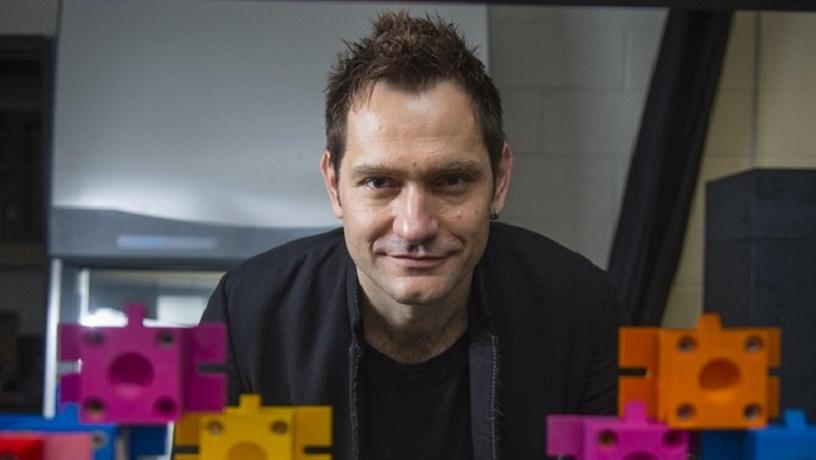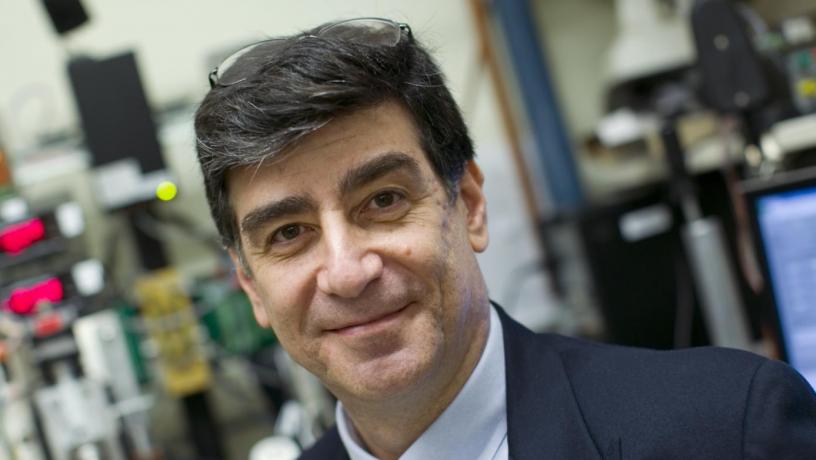New Patent for Laser-Induced Collagen Crosslinking in Tissue
The Department of Mechanical Engineering is pleased to announce that Gerard Ateshian, the Andrew Walz Professor of Mechanical Engineering and Professor of Biomedical Engineering, and Sinisa Vukelic, Lecturer in Discipline in the Department of Mechanical Engineering, have been issued a patent for their novel approach to crosslinking (CxL) technology in biological tissue using femtosecond laser treatment. The innovative process will propel translational treatments for a range of degenerative human tissue conditions, such as keratoconus and knee osteoarthritis.
Over recent years, the duo have collaborated on research that explores the novel use of the femtosecond laser to selectively alter biological tissue. “Sinisa initiated this research thrust in an effort to reshape the cornea for corrective eye surgery to treat corneal diseases such as keratoconus as an alternative to the common LASIK procedure,” explains Ateshian. “As we were already collaborating on another projected regarding Raman spectroscopy of cartilage collagen crosslinks, it occurred to Sinisa that his laser technology could also be used for cartilage, another collagenous tissue. We discussed it and decided to investigate preliminarily if this technology could work for cartilage. When results came back showing a strong effect, we collaborated on an NIH proposal to further investigate this application to cartilage.”
This is the team’s second patent for laser-induced collagen crosslinking technology. “The previous patent application was submitted prior to obtaining experimental results on healthy bovine cartilage and osteoarthritic human cartilage,” explains Ateshian. “The new patent was written with our knowledge of how this technology works for cartilage, based on the preliminary data that convinced us and NIH reviewers, that this technology is promising. However, since the data were preliminary, they were not included in this patent application. Sinisa and I, along with our students C.V. Sise and Jason Fan, plan to publish results in peer-reviewed literature in the near future, demonstrating the effectiveness of this technique.”
The crosslinking technology approach imparts low-density plasma (LDP), which generates an ionization field within biological media without any damaging thermoacoustic and shock waves. When applied to hydrated collagenous tissues such as cartilage, LDP produces reactive oxygen species (ROS) by breaking down water. These species react with surrounding proteins, resulting in crosslink formation, which strengthens the tissue.
“Normally, ROS may be harmful to living cells in tissues, potentially leading to cell death,” explains Vukelic. “However, the ROS generated by the femtosecond laser appear to have a fleeting lifetime, which is too short to cause any evident harm to chondrocytes, as we verified from testing living cartilage explants and confirming that cell viability was maintained for more than 24 hours after treatment.”
The crosslinking method is viewed as a groundbreaking advancement in the field of cornea repair. “Use of infrared light instead of ultraviolet-A light on corneal disease is beneficial because it is non-invasive, permanent and it doesn’t damage the cornea,” explains Vukelic. “The procedure does not require the painful removal of the epithelium that covers the cornea, and it does not induce temporary corneal haze, both of which are common when treating keratoconus with riboflavin activated by UVA light.”
For osteoarthritis, the crosslinking approach holds promise to halt or slow down the disease process if applied early. “We envisage using this technology whenever surgeons are performing routine surgeries or exploratory arthroscopies on patients who have experienced pain or injury to their joint, prior to full-blown osteoarthritis,” says Ateshian. “If the surgeon sees some evidence of cartilage damage, such as surface fibrillation or softening under a probe, they may choose to apply this laser treatment to delay further cartilage degeneration.”
Initial studies show the permanence of crosslinking technology on tissue strengthening. “We only have preliminary data at this time, but the results are encouraging,” says Vukelic. “The original set of cartilage samples that were treated as part of the preliminary studies of our NIH grant proposal were tested again three years later (after being kept in a -80 °C freezer) and their enhanced stiffness was maintained. This preliminary result was very promising, suggesting that the effect of treatment might be long-lasting. Eventually, this hypothesis would need to be tested in vivo for several years.”
“Our crosslinking approach is still in the research stage, but we are encouraged by the initial reactions from clinicians, which have been very positive,” says Ateshian. “More work is needed in both research and development before this technology reaches the clinical phase for use in corneal disorders or osteoarthritis.”
“As our population ages, we hope this technology will be applied to improve human health and quality of life,” says Vukelic.

Sinisa Vukelic, Lecturer in Discipline in the Department of Mechanical Engineering,

